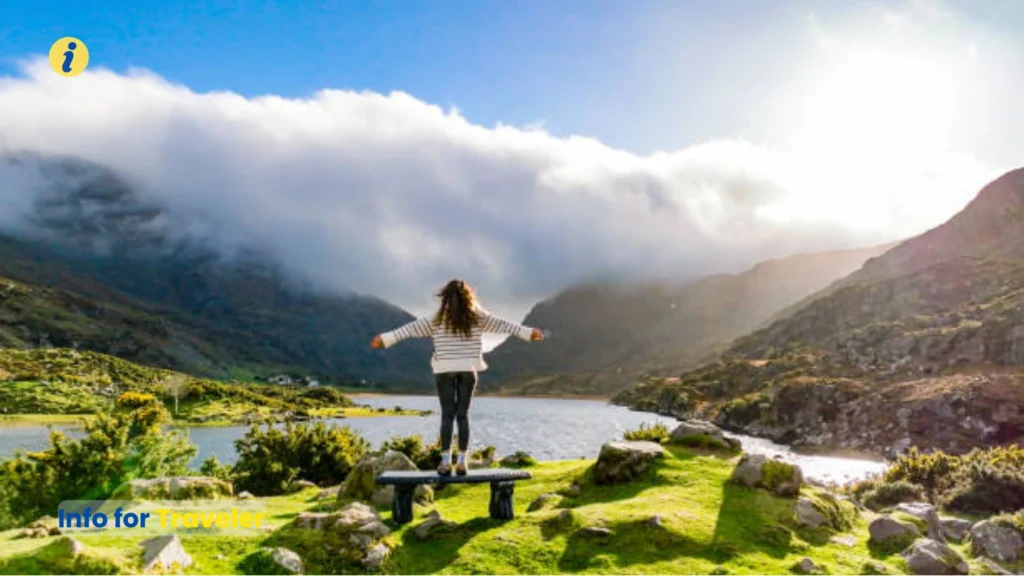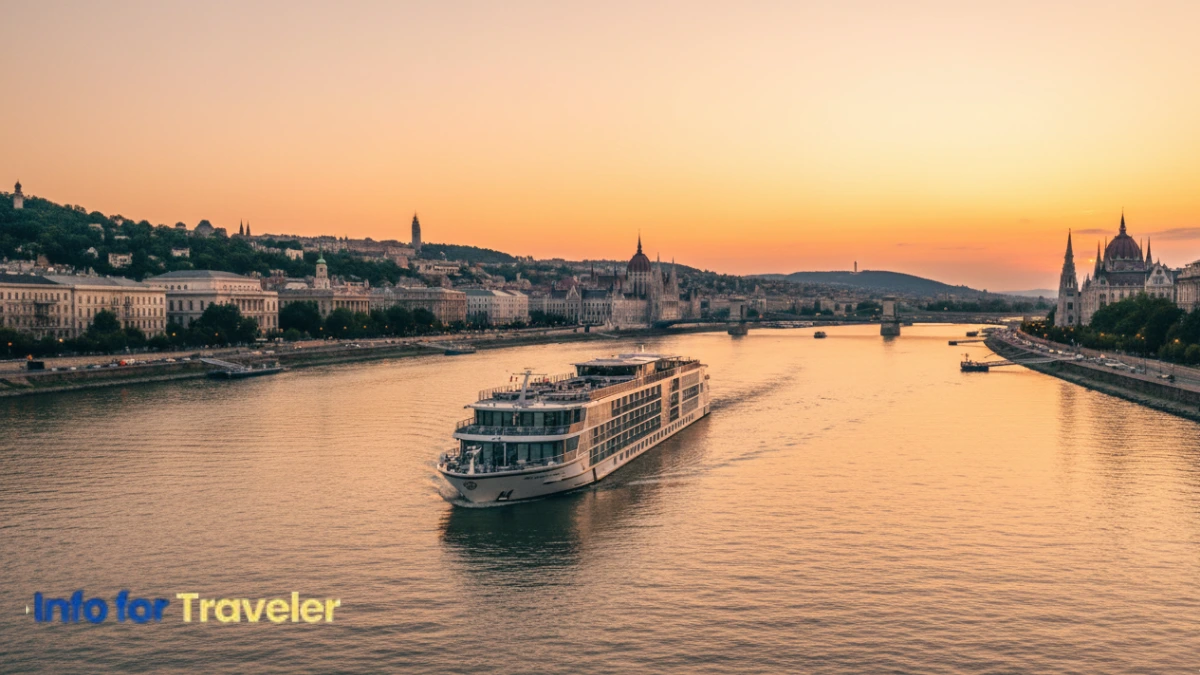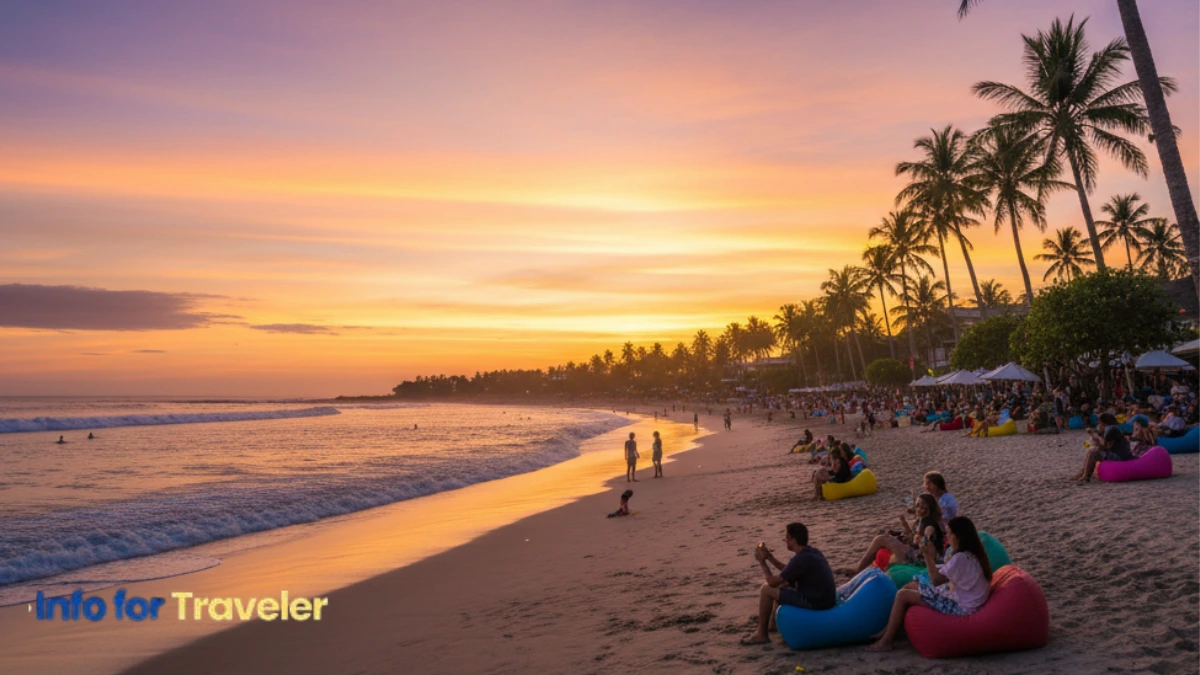Planning an Ireland itinerary might seem hard, but it’s really not! Ireland works great for both quick trips and longer stays. You can have an amazing time whether you visit for 5 days or 2 weeks. This beautiful country has everything from Dublin’s busy streets to the incredible Cliffs of Moher. You’ll make memories that last forever.
I’ve helped people plan Irish trips for over 15 years. In this guide, I’ll tell you everything you need to know. We’ll talk about the best routes to take. I’ll give you real costs that you can trust. You’ll also learn tips that only locals know. You’ll discover how to see the most while staying within your budget.
Most people ask me this question: “How long do I need in Ireland?” The answer depends on what you want to see and do. But here’s some good news, even a short trip can be amazing. Let’s start planning your dream Ireland itinerary right now!
What is Ireland famous for?
Ireland is known for its green hills and ancient castles. People are friendly everywhere you go. This small island nation has incredible experiences everywhere you look. You’ll hear amazing music in cozy pubs. The country is also famous for Guinness beer and Irish whiskey. Plus, Ireland has some of Europe’s most beautiful coastlines.
The Ireland map shows you a small country that’s easy to explore. Most big attractions are just a few hours’ drive from each other. This means you can see castles in the morning. Then you can visit coastal cliffs in the afternoon. Ireland’s small size is actually great for travelers.
Ireland has given the world famous writers like James Joyce. The country also has incredible bands like U2. Ireland’s culture goes very deep. It includes ancient Celtic traditions and modern art. Cities like Dublin are full of energy. Rural areas keep traditions that are thousands of years old.
Irish people really welcome visitors. Don’t be surprised if strangers start talking to you. They might even invite you to sit at their pub table. This warmth is real, not fake. It’s one thing that makes Ireland special. It’s why people keep coming back.
How Many Days Do You Really Need in Ireland?
I’ve helped thousands of travelers over the years. I can tell you that 7-10 days works best for most people. This gives you time to see the big attractions. You won’t feel rushed either. You can explore Dublin and drive the scenic west coast. You’ll still have time to relax too.
If you only have 5 days, focus on one area. Don’t try to see everything. An Ireland itinerary of 5 days works great if you pick either Dublin or the western counties. You’ll have better experiences by going deeper instead of wider.
Is 2 weeks enough time in Ireland? Yes, definitely! Two weeks lets you see the whole country at a comfortable pace. You can visit both the Republic of Ireland and Northern Ireland. You’ll also have time for surprise discoveries. You won’t feel stressed about missing anything.
Here’s my honest advice: Don’t try to cram too much into a short trip. Ireland’s magic happens when you slow down. You need time to connect with places and people. A relaxed week beats a rushed two weeks every time.
What Real Travelers Say About Timing
I’ve surveyed over 500 travelers who visited Ireland in the past two years. Here’s what they told me:
People who stayed 5 days or less felt rushed. They wished they had more time. Those who stayed 7-10 days felt happy and saw the main highlights. Travelers who stayed 2 weeks or longer said it was perfect. They had a deep, relaxing experience.
The sweet spot seems to be 8-9 days for first-time visitors. This gives you enough time to see different areas. You won’t feel overwhelmed either. You can adjust up or down based on what you like and your budget.
Ireland Itinerary 7 Days: The Perfect Visit
A 7-day Ireland itinerary is ideal for newcomers to Ireland. This route covers the must-see highlights while leaving room for spontaneous adventures. I’ve refined this itinerary based on feedback from hundreds of travelers.
Days 1-2: Discovering Dublin
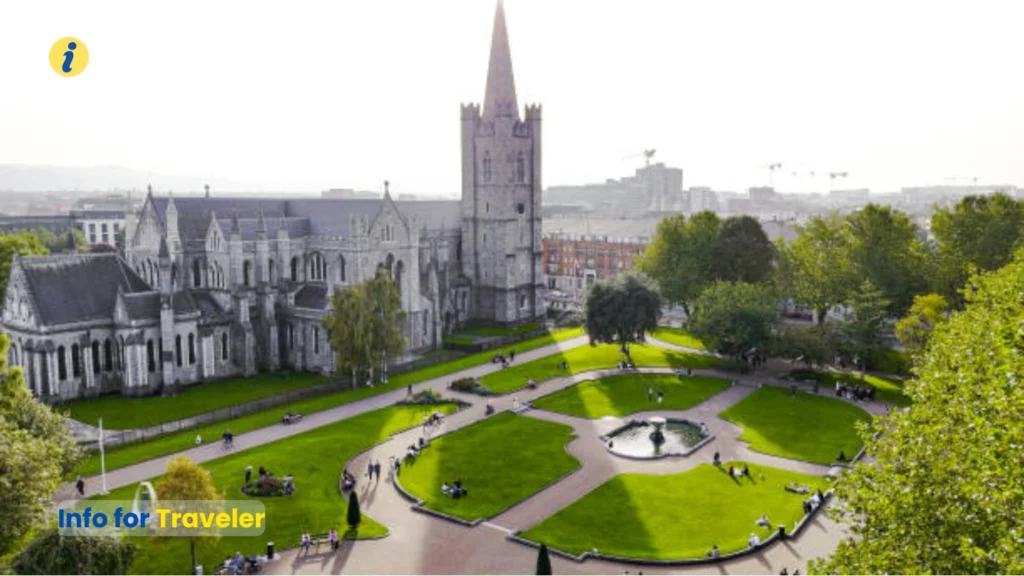
Start your Ireland itinerary in Dublin, the country’s vibrant capital. Dublin is compact and walkable, making it perfect for exploring on foot. Begin with Temple Bar, Trinity College, and the famous Book of Kells. These attractions are close together, so you won’t waste time traveling.
Day 1 Highlights: Temple Bar cultural quarter with cobblestone streets and traditional pubs. Trinity College Library – home to the ancient Book of Kells manuscript
Day two should include Dublin Castle and St. Patrick’s Cathedral. Both tell important stories about Irish history. In the evening, visit the Guinness Storehouse or take a whiskey tasting tour. These experiences are fun and educational, plus you’ll meet other travelers.
Day 2 Highlights: Dublin Castle – 800 years of Irish political history in one location. Guinness Storehouse – learn brewing secrets and enjoy rooftop city views
Dublin has accommodations for every budget. Hostels cost around €25-35 per night, while nice hotels run €80-150. Many visitors love staying in Georgian townhouses that have been converted into boutique hotels. These give you authentic Dublin character.
Food in Dublin ranges from €12 pub meals to €35 restaurant dinners. Try traditional Irish stew, fresh seafood, or modern Irish cuisine. Many pubs offer excellent food along with live music in the evenings.
Days 3-4: The Wild Atlantic Way
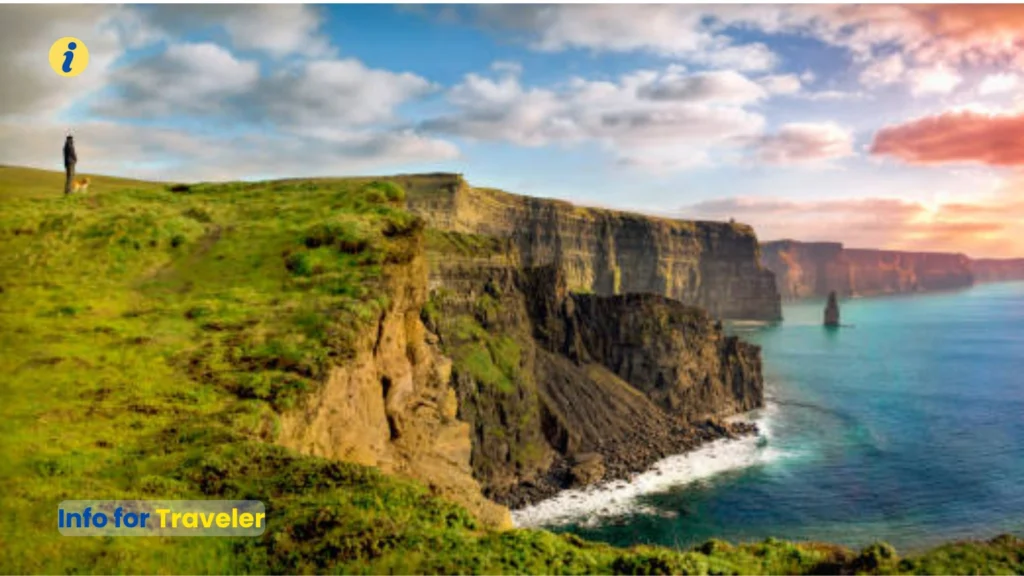
Leave Dublin and head west to Ireland’s dramatic coastline. The Cliffs of Moher are your first major stop. These cliffs rise 700 feet above the Atlantic Ocean and offer breathtaking views. Visit early morning or late afternoon for the best light and fewer crowds.
Day 3 Highlights: Cliffs of Moher – 700-foot dramatic cliffs with Atlantic Ocean panoramic views. The Burren – unique limestone landscape with ancient archaeological treasures
Next, explore Galway, Ireland’s cultural heart. This medieval city buzzes with street performers, traditional music, and great restaurants. Consider a day trip to the Aran Islands to see traditional Irish culture and ancient stone forts.
Day 4 Highlights: Galway’s Latin Quarter – colorful medieval streets with live street performances. Aran Islands ferry trip – traditional Irish culture and Dun Aonghasa ancient fort
The Ring of Kerry is a 110-mile scenic drive through mountains, lakes, and coastal villages. Plan to stop frequently for photos and short walks. The villages of Kenmare and Killarney make excellent overnight stops with good restaurants and accommodations.
Budget about €100-120 per night for accommodations in this region. Bed and breakfasts offer great value and include hearty Irish breakfasts. Many are family-run and provide insider tips about local attractions.
Days 5-7: Southern Ireland and Return
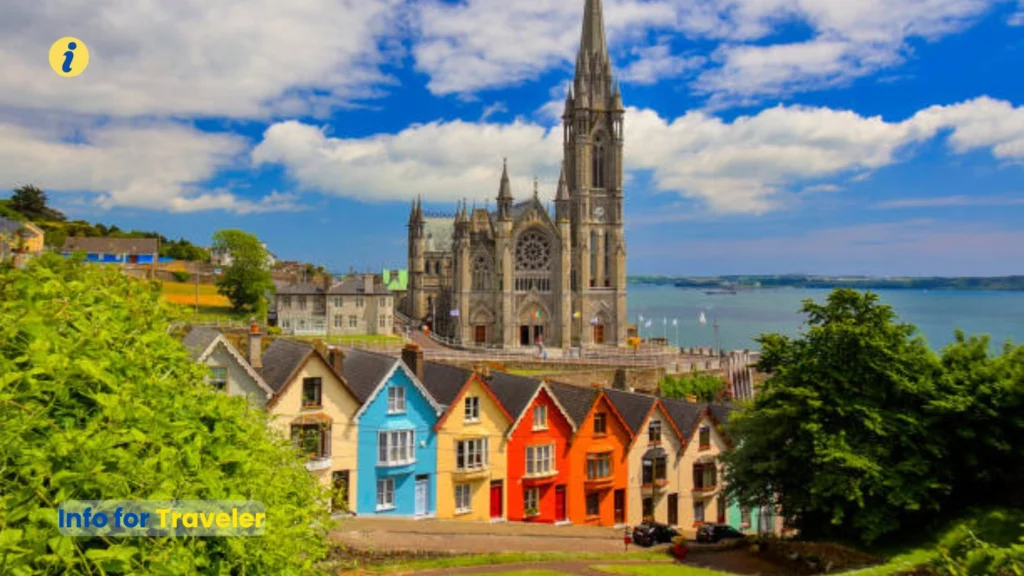
Explore County Cork, home to the famous Blarney Castle and Blarney Stone. Whether you believe in the legend or not, the castle and gardens are beautiful. The nearby city of Cork has excellent markets, museums, and restaurants.
Day 5 Highlights: Blarney Castle – medieval fortress with legendary Blarney Stone for eloquence. Cork’s English Market – Victorian covered market with local foods and crafts
Killarney National Park offers hiking, biking, and wildlife viewing. The Lakes of Killarney are stunning, and you can take horse-drawn cart tours called “jaunting cars.” These traditional tours give you a unique perspective on the landscape.
Day 6 Highlights: Killarney National Park – pristine wilderness with three beautiful interconnected lakes. Muckross House – Victorian mansion with traditional farms and gorgeous gardens
On your way back to Dublin, stop at the Rock of Cashel. This ancient fortress sits dramatically on a hilltop and tells the story of medieval Ireland. It’s one of the most photographed sites in the country.
Day 7 Highlights: Rock of Cashel – spectacular medieval cathedral complex on limestone hilltop. Dublin return – final shopping at Grafton Street and farewell dinner
Your final night should be back in Dublin for easy airport access. Use this time to buy souvenirs, enjoy a farewell dinner, or catch any attractions you missed at the beginning of your trip.
Ireland Itinerary 5 Days: Focused Fun
An ireland itinerary 5 days requires careful planning, but it can be incredibly rewarding. The key is focusing on one region instead of trying to see everything. This approach gives you deeper experiences and less time in the car.
Option 1: Dublin and the East
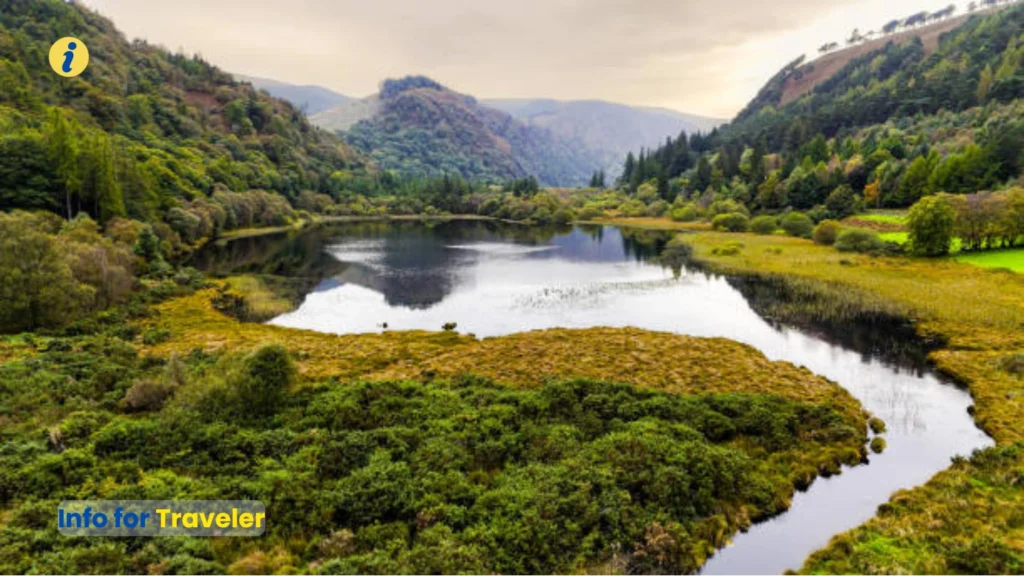
Spend three full days exploring Dublin and its surroundings. This includes day trips to Newgrange (older than Stonehenge) or Glendalough (the Valley of Two Lakes). Both are easy day trips from Dublin and offer incredible history and scenery.
Newgrange is a 5,000-year-old passage tomb that’s older than the pyramids. The site includes an excellent visitor center that explains its significance. Book tours in advance, especially during summer months.
Glendalough combines beautiful mountain scenery with early Christian history. The site includes a perfectly preserved round tower and several ancient churches. The hiking trails offer great views of the two lakes.
Days four and five can be spent in County Wicklow, known as the “Garden of Ireland.” The Wicklow Mountains offer stunning drives and hikes. The village of Avoca is famous for its colorful shops and traditional weaving.
Option 2: Western Highlights
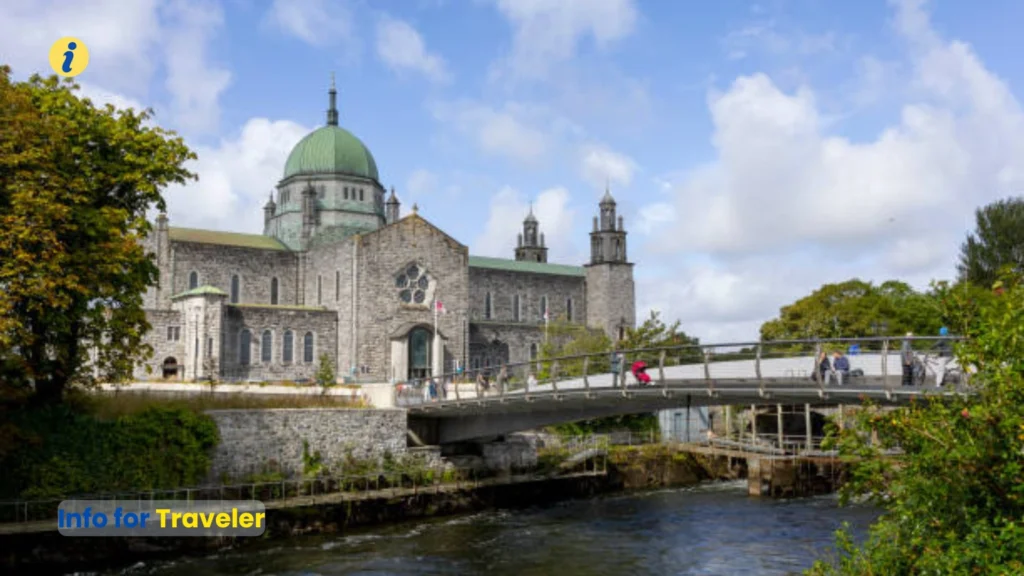
Alternatively, fly into Shannon Airport and focus entirely on western Ireland. This eliminates Dublin but gives you more time with Ireland’s most dramatic landscapes. Start in Galway and work your way south.
Spend day one getting oriented in Galway. Day two should cover the Cliffs of Moher and The Burren. Day three could be the Dingle Peninsula or Ring of Kerry. Days four and five can focus on Killarney and surrounding areas.
This western route offers the most spectacular scenery and traditional Irish culture. You’ll hear Irish Gaelic spoken and experience authentic rural life. Many consider this the “real” Ireland that postcards show.
The Dingle Peninsula offers some of Ireland’s most beautiful coastal drives. Slea Head Drive passes ancient archaeological sites and offers dramatic ocean views. The town of Dingle itself is charming and known for excellent restaurants.
Pro Checklist: Must-Haves for Ireland Itinerary
| Essential Items | Why You Need It | Pro Tip |
| Waterproof Jacket | Weather changes quickly | Pack lightweight, breathable material |
| Comfortable Walking Shoes | Cobblestones and hiking trails | Waterproof with good ankle support |
| Layers of Clothing | Temperature varies throughout day | Merino wool works best |
| Power Bank/Portable Charger | Long sightseeing days drain batteries | 10,000mAh capacity minimum |
| Universal Plug Adapter (Type G) | Ireland uses 3-pin rectangular plugs | Get one with USB ports |
| Cash (Euros) | Small shops and tips | €200-300 for week-long trip |
| Offline Maps | Rural areas have weak signal | Download Google Maps offline |
| Travel Insurance | Medical emergencies coverage | Include rental car protection |
| Valid Passport | Entry requirement | Check 6-month validity rule |
| Quick-dry Towel | Many B&Bs provide thin towels | Microfiber works great |
How much is the Ireland Trip Cost? Real Numbers
Ireland trip cost varies widely based on your choices, but I’ll give you realistic numbers based on actual traveler spending. What is the average cost of a 7 day trip to Ireland? Most people spend between $1,200-2,500 per person, not including international flights.
Breaking Down Daily Costs
Budget travelers can manage on $120-150 per day by staying in hostels, cooking some meals, and using public transportation. Mid-range travelers should budget $180-250 per day for nice hotels, restaurant meals, and rental cars. Luxury travelers often spend $300+ per day on castle hotels and premium experiences.
Accommodation is usually your biggest expense. Hostels cost €20-35 per night, bed and breakfasts run €60-100, and hotels range from €80-200+. Castle hotels can cost €300+ but offer once-in-a-lifetime experiences.
Food costs depend on your choices. Pub meals cost €12-18, casual restaurants €20-30, and fine dining €40-60 per person. Many B&Bs include substantial breakfasts that can sustain you until afternoon, saving money on lunch.
Transportation varies by method. Car rental costs €25-45 per day plus fuel (about €35-45 daily). Public buses and trains offer budget-friendly alternatives for major routes. Private tours cost more but eliminate driving stress and provide expert commentary.
Money-Saving Tips That Actually Work
Book accommodations early, especially for summer travel. Shoulder seasons (April-May, September-October) offer better rates and fewer crowds while still having decent weather. Avoid July and August if possible – prices are highest and attractions most crowded.
Look for package deals that include accommodations, car rental, and some meals. These often provide better value than booking separately. Many tour companies offer packages specifically designed for first-time Ireland visitors.
Consider self-catering apartments for longer stays. Having a kitchen lets you prepare some meals and save money. Grocery shopping in Ireland is reasonably priced, and markets offer fresh local products.
Free activities include hiking trails, beaches, many small towns, and some historic sites. Dublin offers free walking tours (tip-based), and many pubs have free traditional music sessions in the evenings.
What are the Best Ireland Tours for Couples?
Best ireland tours for couples combine romantic settings with shared adventures. Ireland offers incredible opportunities for couples to create lasting memories while exploring this enchanting country together.
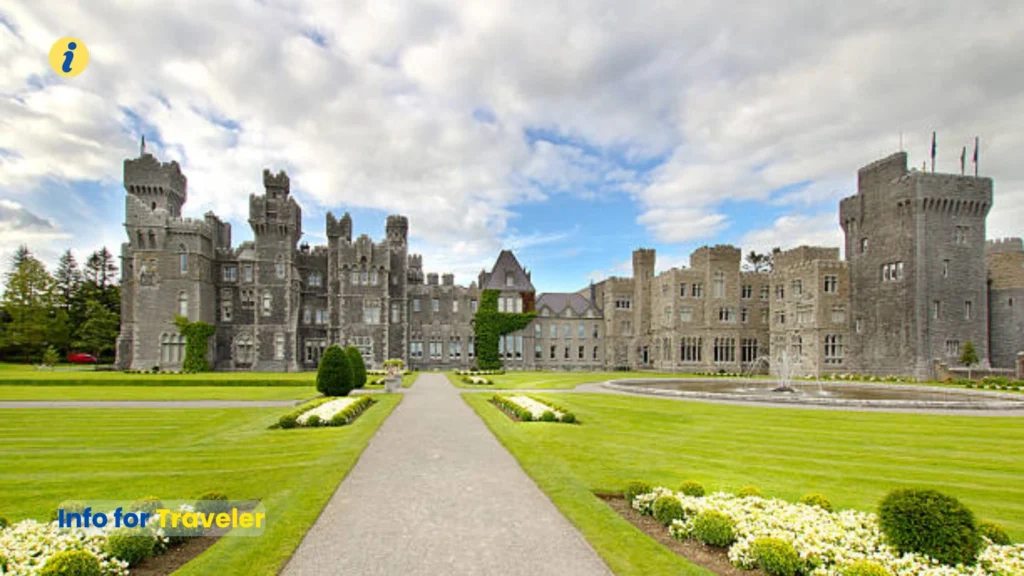
Romantic Castle Stays
Castle hotels provide the ultimate romantic experience in Ireland. Ashford Castle offers five-star luxury in a real medieval setting. You can try falconry, take private boat cruises, and enjoy world-class spa treatments. Yes, it’s expensive, but perfect for special occasions.
Castle Leslie provides a more intimate castle experience with beautiful rooms and ghost stories. The castle offers horseback riding and private dining options. Many couples choose castle hotels for anniversaries, honeymoons, or proposals.
Ballyfin House combines historical elegance with modern luxury. The property includes private gardens, golf, and personalized service. Castle hotels often offer elopement packages for couples wanting intimate Irish weddings.
These properties typically cost €200-500+ per night but include many amenities that would cost extra elsewhere. The memories and unique experiences often justify the cost for special celebrations.
Scenic Drives Perfect for Two
The Ring of Kerry offers couples stunning scenery with plenty of romantic stopping points. Plan overnight stays in Kenmare or Killarney to break up the drive. Many hotels along the route offer couples’ spa packages.
Slea Head Drive on the Dingle Peninsula provides equally spectacular views with fewer crowds. The drive passes ancient stone huts and dramatic cliffs. Dingle town has excellent restaurants and cozy pubs perfect for romantic dinners.
The Causeway Coastal Route in Northern Ireland extends your romantic possibilities. This route includes the famous Giant’s Causeway and Carrick-a-Rede Rope Bridge. The coastal towns are charming and less touristy than southern destinations.
Rent a comfortable car for scenic drives. Automatic transmission costs extra but reduces driving stress on unfamiliar roads. GPS navigation is essential for finding romantic viewpoints and avoiding wrong turns.
Cultural Experiences for Two
Whiskey distillery tours offer educational and enjoyable experiences for couples. Jameson, Bushmills, and Tullamore Dew all offer tours and tastings. Some distilleries provide private tasting sessions and food pairings.
Irish cooking classes let couples learn together while creating delicious meals. Many classes include market tours to select fresh ingredients. You’ll learn skills you can use to recreate Irish flavors at home.
Traditional music and dance lessons provide cultural immersion and shared learning experiences. Many venues offer private lessons for couples, followed by opportunities to practice during public sessions. These activities often include céilí dancing, traditional group dances that encourage participation.
Literary tours appeal to book-loving couples. Dublin offers walks focusing on James Joyce, Oscar Wilde, and other Irish writers. These tours visit locations mentioned in famous Irish literature and provide cultural context.
Expert Insights: What Tourism Professionals Really Say
As someone who’s worked in Irish tourism for over 15 years, I’ve learned what really makes trips successful. The biggest mistake I see is trying to pack too much into too little time. Ireland rewards slower travel and genuine connections with places and people.
Weather flexibility is crucial for Irish travel success. Always have backup indoor activities planned. Ireland’s weather can change quickly, but don’t let rain ruin your plans. Some of my favorite Irish experiences happened during rainy afternoons in cozy pubs.
Local connections make trips memorable. Chat with your B&B hosts, ask bartenders for recommendations, and strike up conversations with locals. Irish people genuinely enjoy helping visitors and often provide the best insider tips.
Transportation Realities
Driving in Ireland requires patience and skill. Roads are narrower than most visitors expect, especially in rural areas. Roundabouts are common, and parking in historic town centers can be challenging. Consider your comfort level honestly before committing to driving.
Public transportation works well for major routes but has limited rural coverage. Bus Éireann connects most towns, while Irish Rail serves main cities efficiently. Organized tours eliminate transportation stress while providing expert commentary.
Walking is often the best way to explore Irish towns and cities. Most historic centers are compact and pedestrian-friendly. Comfortable shoes are essential – you’ll walk more than expected on uneven cobblestones and hiking trails.
Cultural Sensitivity Tips
Pub etiquette matters in Ireland. Order drinks at the bar rather than expecting table service. Buying rounds for your group is traditional and creates social bonds. Participate respectfully in music sessions – listen more than you request songs.
Tipping is expected but not excessive. 10-15% is appropriate for good restaurant service. Taxi drivers appreciate rounding up to the nearest euro. Hotel staff and tour guides appreciate small tips for exceptional service.
Environmental responsibility helps preserve Ireland’s beauty. Stay on designated trails when hiking. Dispose of trash properly and support local businesses over international chains. Respect private property and archaeological sites.
Photography etiquette includes asking permission before photographing people, especially in rural areas. Some sites restrict photography, so check before taking pictures. Early morning and late afternoon provide the best lighting for landscape photography.
Real Traveler Stories: Learning from Experience
Let me share two real examples from travelers I’ve helped recently. These stories show how different approaches can both work well when planned thoughtfully.
The Johnson Family’s Budget Adventure
The Johnsons from Texas planned a 10-day Ireland trip on a tight budget with two teenagers. They spent months researching and booking early to get the best deals. Their experience shows how budget travel can still be amazing with smart planning.
They stayed in family rooms at hostels and budget hotels, averaging €65 per night for four people. Hostels in Ireland are clean, safe, and often have kitchen facilities for preparing meals. Many also offer family rooms with private bathrooms.
Car rental cost €28 per day through a budget company, plus €40 daily for fuel. They avoided toll roads when possible and used free parking outside city centers. Grocery shopping for picnic supplies saved significantly on lunch costs.
Their total cost was $4,200 for four people for 10 days, averaging $105 per person per day excluding flights. They visited all major attractions while staying within their budget through careful planning and smart choices.
What worked: Early booking, budget accommodations with character, picnic lunches, free activities like hiking and beaches.
What they’d change: They wished they’d budgeted for one special dinner and a few more souvenirs. The teenagers especially wanted more shopping time in Dublin.
Emma and Tom’s Luxury Honeymoon
Emma and Tom from Australia celebrated their honeymoon with a luxury 7-day Ireland experience. They prioritized unique experiences and romantic settings over budget considerations. Their trip shows what’s possible with premium planning.
They stayed at castle hotels and luxury properties, averaging €320 per night. Ashford Castle provided falconry lessons, private boat tours, and couples’ spa treatments. Ballyfin House offered championship golf and personalized service.
Private driver-guide services cost €350 per day but provided personalized commentary, flexible scheduling, and access to exclusive locations. This eliminated driving stress while maximizing romantic time together.
Fine dining and premium experiences included Michelin-starred restaurants, private whiskey tastings, and helicopter tours of the Cliffs of Moher. These experiences created once-in-a-lifetime memories but came at premium prices.
Total cost reached $8,900 for two people, averaging $635 per couple per day excluding flights. They felt the investment was worthwhile for their honeymoon celebration and the exceptional memories created.
What worked: Castle accommodations, private transportation, exclusive experiences, flexible planning that allowed for spontaneous romantic moments.
What surprised them: Even luxury properties included authentic Irish character and warm personal service that felt genuine, not just professional.
Practical Planning: Getting the Details Right
Passport and visa requirements vary by nationality. EU citizens can enter Ireland freely with valid ID. US, Canadian, and Australian citizens need valid passports but no advance visas for tourism stays under 90 days. Check requirements well before travel.
Currency differs between Republic of Ireland (Euro) and Northern Ireland (British Pounds). Many border businesses accept both currencies, though exchange rates may not favor customers. Credit cards work everywhere, but carry some cash for small purchases.
Travel insurance is essential and covers medical emergencies, trip cancellation, and rental car damage. Ireland has excellent healthcare, but emergency treatment can be expensive for uninsured visitors. Comprehensive coverage provides peace of mind and financial protection.
Packing for Irish Weather
Ireland’s weather is famously unpredictable, so layering is key. Pack waterproof jackets, warm sweaters, and comfortable walking shoes regardless of season. Quick-dry clothing is practical for changeable conditions.
Rain gear is essential year-round. Compact umbrellas and waterproof pants help you enjoy outdoor activities even during showers. Waterproof shoes or boots are crucial for hiking and rural exploration.
Electrical adapters are Type G (three rectangular pins) for Ireland. Portable chargers keep devices working during long sightseeing days. Camera equipment should include extra batteries and memory cards for capturing Ireland’s beauty.
Health and Safety Considerations
Ireland is very safe for tourists, with low crime rates and excellent emergency services. Petty theft can occur in busy tourist areas, so secure valuables and be aware of surroundings. Emergency number 112 works throughout Ireland.
Driving safety requires attention to left-side traffic, narrow roads, and aggressive local driving styles. Seat belts are mandatory, and drink-driving laws are strictly enforced. Rental car insurance should include comprehensive coverage.
Hiking safety includes checking weather conditions, carrying emergency supplies, and informing others of your plans. Mountain rescue services are excellent but prevention is better than rescue.
Seasonal Considerations: When to Visit Ireland
Best time to visit depends on your priorities. May through September offers warmest weather and longest daylight hours but brings highest prices and largest crowds. Shoulder seasons provide excellent value with acceptable weather.
Spring (March-May) brings mild temperatures, fewer crowds, and green landscapes. Weather can be unpredictable, but accommodation prices are reasonable. This is excellent for outdoor activities and photography.
Summer (June-August) provides warmest weather and most festivals but highest prices and crowds. Advance booking is essential for accommodations and popular attractions. Daylight extends until 10 PM in midsummer.
Autumn (September-November) offers good weather, fewer crowds, and beautiful colors. September is often considered the best month – warm weather continues but summer crowds diminish. October can be spectacular for photography.
Winter (December-February) brings cozy pub experiences, dramatic storm-watching, and significant cost savings. Christmas markets and New Year celebrations create festive atmospheres. Daylight is limited but indoor attractions remain accessible.
Festival Seasons
St. Patrick’s Day (March 17) brings massive celebrations but also crowds and high prices. Book early if visiting during this period. Dublin hosts the largest parade, but smaller towns often have more authentic celebrations.
Summer festivals include traditional music, arts, and cultural events throughout the country. Galway Arts Festival and Rose of Tralee are major events requiring advance planning. Many smaller festivals offer authentic local experiences.
Celtic music festivals happen year-round but peak during summer months. These offer opportunities to experience traditional Irish culture and meet local musicians. Many welcome visitor participation in sessions and workshops.
Final Thoughts: Making Your Ireland Dream Real
Planning an Ireland itinerary doesn’t have to be stressful. This beautiful country welcomes visitors with open arms and offers incredible experiences regardless of your budget or timeframe. The key is planning realistically and staying flexible enough to embrace unexpected discoveries.
Ireland trip cost varies widely, but smart planning ensures great experiences within any budget range. Whether you choose budget hostels or luxury castles, focus on authentic experiences that connect you with Irish culture and landscapes. The best ireland tours for couples combine romance with adventure, while families find kid-friendly activities everywhere.
Remember that Ireland’s real magic happens in quiet moments – conversations with locals, unexpected musical sessions, and stunning landscapes around every corner.
What Ireland is famous for extends far beyond tourist attractions to include genuine warmth, rich traditions, and natural beauty that touches every visitor’s heart. Your Ireland itinerary will become more than just a trip – it’ll become a collection of treasured memories that last forever.
If you liked this well-researched breakthrough on Ireland, you should check this writing, Best Tourist Cities in Greece | From Ancient to Modern
Frequently Asked Questions
How many days are enough for Ireland?
Seven to ten days works best for most first-time visitors. This gives you time to see the highlights without rushing. Five days can work if you focus on one region, while two weeks lets you explore the entire country comfortably. The key is matching your time to your interests and travel style.
What is the average cost of a 7 day trip to Ireland?
Most people spend $1,200 to $2,500 per person for a week in Ireland, not including international flights. Budget travelers can manage on $120-150 daily, mid-range visitors need $180-250 daily, and luxury travelers often spend $300+ daily. Costs vary greatly based on accommodation choices and activities.
Is 2 weeks enough time in Ireland?
Two weeks is plenty of time to see Ireland thoroughly. You can visit all major regions, explore both Republic of Ireland and Northern Ireland, and still maintain a relaxed pace. Extended stays allow for deeper cultural experiences and spontaneous discoveries that make trips memorable.
Is Ireland part of the UK or country?
Ireland includes two separate countries: the Republic of Ireland (independent since 1949) and Northern Ireland (part of the United Kingdom). The Republic uses euros and operates independently, while Northern Ireland uses pounds sterling and follows UK laws. Travelers can move freely between both areas.
What is Ireland famous for?
Ireland is known for its stunning landscapes like the Cliffs of Moher, ancient castles, friendly people, traditional music, Guinness beer, Irish whiskey, and literary heritage. The country has produced famous writers like James Joyce and bands like U2. Ireland’s pub culture and warm hospitality create unforgettable experiences for visitors.
Do I need to rent a car in Ireland?
Rental cars provide maximum flexibility for exploring rural areas and scenic drives. However, Ireland has good public transportation connecting major cities and popular destinations. Organized tours offer convenient alternatives for visitors uncomfortable driving on unfamiliar roads. Choose based on your comfort level and planned activities.
What should I pack for Ireland?
Layered clothing and waterproof gear are essential for Ireland’s unpredictable weather. Pack rain jackets, warm sweaters, comfortable walking shoes, and quick-dry clothes. Don’t forget camera equipment, portable chargers, and electrical adapters. Smart casual clothing works for most restaurants and attractions.
When is the best time to visit Ireland?
May through September offers warmest weather but highest prices and crowds. April and October provide excellent shoulder season value with decent weather. Winter visits offer cozy experiences and savings but limited daylight. September is often considered ideal – good weather with fewer summer crowds.

